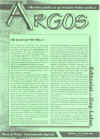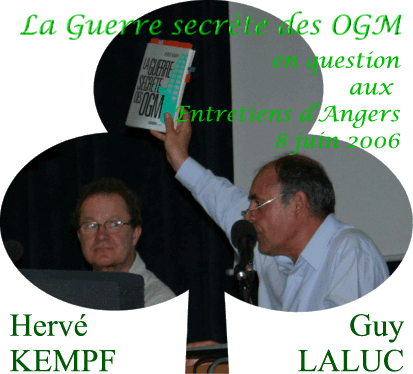|
 2006
2006
The
3rd « Entretiens d'Angers »

at
the ESA in Angers on the 8th June 2006

Introduction
par
Mr
Parmentier (ESA)
avec
entre autre Marie-Hélène Aubert, députée européenne Verte, vice
présidente de la Commission agriculture au Parlement européen et Hervé
Kempf, journaliste au MONDE, auteur de 'La Guerre Secrète des OGM'
contacter
Guy
LALUC :
ARGOS.Laluc@wanadoo.fr
Tel: +33 (0)2 41 73 01 34
Fax:
+33 (0)2 41 36 08 09

(pdf 1.8 MB)

Laurent
Lewandowski
GERMA

Alain
Baranger
Verte
France
ENTRETIENS
D'ANGERS
mardi 13 novembre
2007
|
contacter
Guy
LALUC :
ARGOS.Laluc@wanadoo.fr
Tel: +33 (0)2
41 73 01 34
mobile +33 (0)6 81 61 21 17
Fax: +33 (0)2
41 36 08 09 |
argos
Agri-cultural exemption and WTO
L'exception agri-culturelle et l'OMC
|
|
HERVE KEMPF
LA GUERRE SECRETE
DES OGM
Entre 1973 et 2003, nous avons vécu un phénomène nouveau : pour la première fois depuis les débuts de la Révolution industrielle, la société humaine a refusé une mutation technologique. Alors qu'elle promettait de transformer le monde, la dissémination dans l'environnement des oganismes génétiquement modifiés (OGM) s'est heurtée à une contestation planétaire. Les OGM sont maintenant confinés pour l'essentiel en Amérique du Nord, et les firmes qui les promeuvent s'enfoncent dans la crise.
Personne ne peut prédire l'avenir des OGM, des plantes transgéniques. Mais l'échec de leur lancement est riche d'enseignements : sur l'Europe, qui y a manifesté sont unité, sur les Etats-Unis, qui y ont montré la maladie de leur démocratie, sur la redécouverte de l'agriculture par un monde urbanisé, sur les rapports entre la politique et la science. Mais l'histoire des OGM est d'abord une incroyable aventure, une véritable "guerre de trente ans" mêlant la passion et la cupidité, le commerce et la manipulation, l'enthousiasme scientifique et l'imprudence. Cette guerre fut aussi une guerre secrète et ce livre lève une partie du voile.
Hervé Kempf couvre le journal Le Monde les questions d'écologie internationale. Journaliste scientifique, il a publié plusieurs livres, dont l'un, La Révolution biolithique. Humains artificiels et machines animées (Albin Michel, 1998), constitue l'une des meilleures synthèses au sujet des nouveaux défis
biotechnologiques.
édition
du Seuil
|
|
|
Les
tests toxicologiques ?
Silence,
secret industriel...
Le
Monde, le 09 Février
par
Hervé Kempf
DANS
l’Union européenne, les dossiers d’autorisation d’OGM
incluent un dossier d’évaluation toxicologique qui comporte
souvent une étude d’alimentation sur animaux. Dans celle-ci,
plusieurs groupes de rats ou de souris sont nourris, les uns avec
la céréale transgénique, les autres avec la variété de céréale
correspondante mais non transgénique. Au bout de 90 jours, les
rongeurs sont sacrifiés et examinés.
L’étude
représente un travail important et très coûteux, réalisé par
la firme demandeuse. Les comités publics qui examinent les
demandes d’autorisation (CGB en France, EFSA en Europe) ne procèdent
pas eux-mêmes aux études.
Le
dossier d’autorisation reste confidentiel. Mais cette
confidentialité est contestée depuis qu’en 2004 il est apparu
que certains OGM, dont leMON 863 produit par l’américain
Monsanto, provoquaient des effets biologiques chez les animaux
testés. Le 9 juin 2005, la cour d’appel de Münster (Allemagne)
a ordonné à Monsanto de publier le document.
Mais
les dossiers des autres OGM restent secrets. A plusieurs reprises,
en France, la Commission d’accès aux documents administratifs,
saisie par le Comité de recherche et d’information indépendantes
sur le génie génétique, a enjoint à l’administration de
publier les dossiers toxicologiques dont elle avait connaissance.
Le gouvernement français s’y est refusé. En septembre 2005, il
a demandé une réunion européenne pour discuter de la
confidentialité des données :
« De telles communications, écrivait-il, sont
susceptibles d’entacher la confiance de l’opinion publique
dans le processus de gestion du risque, mais également de nuire
à la position concurrentielle de l’entreprise. » Chez Monsanto
France, on explique : « La confidentialité est une question de
principe de protection de nos données scientifiques par rapport
à la concurrence. »
Pourtant, la directive européenne 2001-18 spécifie
que les données concernant la santé ne peuvent être considérées
comme confidentielles. Dans une réunion sur le sujet le 8
novembre 2005, la Commission ainsi que plusieurs pays, comme la Suède
ou la Grande-Bretagne, ont pris position pour la transparence. Les
experts eux-mêmes en sont partisans : « Toutes les données
relatives à la sûreté devraient être publiées », assure
Harry Kuiper, directeur du groupe OGM de l’EFSA. A Bruxelles, la
direction de la santé et de la protection des consommateurs
indique qu’une décision sur la transparence sera prochainement
annoncée. « Notre approche est d’une transparence maximale,
sauf pour les données personnelles ou pour celles qui posent un
vrai problème commercial. »
H. K.
lire
l'article pdf 171 KB
|
Toxicological
test files ?
Be
quiet, industrial secret ...
IN the European Union, the
application dossiers to authorise GMO include a toxicological
evaluation file, which often contains an animal feed study. In the
latter, several groups of rats or mice are fed, some with a
transgenic cereal, others with the corresponding variety of cereal
except that it is not transgenic. At the end of 90 days, the
rodents are killed and examined.
The
study represents an important and very expensive work, made by the
applicant company. The public committees which examine the
application for marketing authorisation (CGB in France, EFSA in
Europe) do not produce themselves to the studies.The
application file remains confidential. But this confidentiality is
disputed since in 2004 when it appeared that a number of GMO,one
of which MON 863 produced by the American Monsanto, caused
biological effects to the tested animals. On June 9th, 2005, the
Court of Appeal of Münster (Germany) ordered Monsanto to publish
the document.
But the files for other GMO
remain secret. Repeatedly, in France, the Commission for access to
administrative documents, referred to by the Committee of
independent research and information on genetic engineering,
ordered the administration to publish toxicological files the
existence of which it had the knowledge. The French government
refused. In September, 2005, it asked for a European meeting to
discuss the confidentiality of data: « such communications, it
wrote, could undermined the confidence of public opinion in the
process of risk management, but also damage the competitive
position of the company. » At Monsanto France, someone explains:
« Confidentiality is a question of principal of protection of our
scientific data with regard to the competition. »
Nevertheless, the European
directive 2001-18 determines that data relating to health cannot
be considered as confidential. In a meeting on the subject on
November 8th, 2005, the Commission as well as several countries,
like Sweden or Great Britain, took side in favour of transparency.
The experts themselves are in favour: « All the data relating to
safety should be published », assures Harry Kuiper, director of
the group GMO within EFSA. In Brussels, the head of DG SANCO
(health and consumer protection) indicates that a decision on
transparency will soon be announced. « Our approach is of maximal
transparency, except for particulars (personal data) or for such
data that raise a real commercial problem. »
translation
audace : sdd@audace-ass.com
New Suspicions about GMOs |
|
|
|
|
| Agricultores
franceses apóiam Paraná na luta contra transgênicos |
O AUDACE
au Brésil
food for thought
Daniel Roques with Vice Governor Orlando Pessuti
For the president of AUDACE speaking in Curitiba
(Paranã) May 28th of this year, genetically modified seeds such as marketed by Monsanto today in Brazil threaten food security and economic and political independence.
Daniel
Roques avec le Vice Gouverneur Orlando Pessuti
Pour
le président d'AUDACE s'exprimant à Curitiba (Paranã) le 28 mai
dernier, les plantes génétiquement modifiées telles que
commercialisées par Monsanto aujourd'hui au Brésil menacent
l'indépendance alimentaire, économique et politique.
Para
o presidente da Audace, os transgênicos representam a perda da
independência alimentar, econômica e política.
Vice-Governador
Orlando Pessuti esteve reunido neste domingo (28), em Curitiba, com
empresários europeus interessados em apoiar o Estado do Paraná em
suas ações contra os transgênicos. O grupo foi liderado pelo
presidente da Associação de Usuários e Distribuidores de Agroquímicos
na Europa (Audace), Daniel Roques.
New Suspicions about GMOs
By Herve Kempf
Le Monde, 9 February 2006
Do transgenic plants have a negative effect on health? Ever since their commercialization in 1996, the question has agitated circles of experts and ecologists, without any indisputable proof allowing an affirmative response. Now, several recent studies effected by credible researchers and published in scientific reviews tally with one another to throw doubt on GMOs' complete harmlessness. They don't assert that GMOs generate health problems. But at the very least they suggest that GMOs provoke biological impacts that must be more widely studied. This new questioning arises just as the Council of Ministers adopted a proposed law on GMO Wednesday, February 8, and as the World Trade Organization (WTO) handed over an interim report February 7 to the parties in a conflict that opposes the United States, Canada, and Argentina to the European Union on the issue of transgenic plants.
http://www.truthout.org/cgi-bin/artman/exec/view.cgi/33/17559
In November 2005, Australian researchers published an article in a scientific review (Vanessa Prescott et al., Journal of Agriculture and Food Chemistry, 2005, p. 9023) explaining that the transfer of a gene that expresses an insecticide protein from a bean to a pea had provoked unexpected problems: among the mice fed the transgenic peas, CSIRO (the Australian equivalent of the French National Center for Scientific Research, CNRS) researchers observed antibody production, markers of an allergic reaction. The affair, which made headlines in the Australian and English press, led Csiro to stop development of that transgenic pea, while West Australia Minister of Agriculture Kim Chance announced that his government would finance an independent study on feeding animals with GMO: "The state government is aware of the anxiety concerning GMO safety, while most of the research in this domain is conducted or financed by the very companies promoting GMO," Mr. Chance explained in a November 2005 communique.
During the summer of 2005, it was an Italian team led by Manuela Malatesta, cellular biologist at the Histological Institute of the University of Urbino, that published intriguing results (European Journal of Histochemistry, 2005, p. 237). In prior studies, that team had already demonstrated that absorption of transgenic soy by mice induces modifications in the nuclei of their liver cells. This summer's publication proved that a return to non-transgenic food made the observed differences disappear. It also showed that several of these changes could be "induced in adult organisms in a very short time."
In Norway, Terje Traavik, scientific director of the University of Tromsso's Institute of Genetic Ecology, just published a study in European Food Research and Technology (January 2006, p. 185): he demonstrates that an element of the genetic structures used to modify a plant, the catalyst 35S CaMV, can provoke gene expression in cultured human cells. Now, according to GMO promoters, that catalyst normally only operates that way in plants.
The increase in these experiments led the FAO (the United Nations' Food and Agriculture Organization) to organize a seminar on the safety of transgenic food in October 2005, bringing together the best specialists on the question. "What came out of it was that we have to pay attention to this type of study," said FAO seminar coordinator Ezzedine Boutrif. "In several cases, GMOs have been put on the market when the safety issues were not very clear."
The researchers involved in these recent studies declare their neutrality. "I had no preconceived idea about GMOs when I began my research in 2000," says Manuela Malatesta. "I thought they weren't dangerous because we had been eating them for a long time. But there was virtually no scientific literature on the subject. Consequently, we thought it was useful to undertake some studies." For Terje Traavik, the initial motivation was different: "I was doing cancer research using transgenesis. My colleagues and I knew that it would pose a problem if it left the laboratory. That concern convinced us that we needed to study this type of risk."
This work attracts all the more attention in that, in the United States as well as in Europe, research on the impacts of GMO has not been encouraged by governments. Toxicological studies were effected by the companies promoting GMOs, the impartiality of which is debatable, and subsequently examined by commissions. But the latter never reproduced the experiments, which remain secret. Yet those studies sometimes also show notable biological impacts.
On April 23 2004, Le Monde revealed that experts from the Commission on Biomolecular Genetics (CGB) were divided over the effects of a Monsanto corn, MON 863. In the toxicological study that had been communicated to them, it seemed that rats fed with the GMO presented several anomalies: an increase in white blood cell count, blood sugar changes, reduction of red blood cell count, etc. A debate followed between the agencies concerned that led to a favorable CGB opinion. Although the experts re-examined the file, they did not, however, take a new look at the statistical analysis presented by Monsanto.
http://www.truthout.org/docs_04/121504H.shtml
Associations including Greenpeace demanded publication of the toxicological file so that they can submit it to a second opinion. On June 9, 2005, the Munster, Germany, Court of Appeal ordered its publication. Greenpeace then consigned two French researchers, Gilles-Eric Seralini, of the University of Caen, and Dominique Cellier, of the University of Rouen, to prepare a statistical second opinion of the case. They are supposed to publish the results of their study in February. "Monsanto's statistical analysis of the differences observed in the rats was very superficial," observes Dominique Cellier, who is a biocomputer specialist. "They isolate the variables instead of using so-called multi-variable analysis methods, which consist of looking at the observed anomalies in a coherent way. If one uses those methods, one observes coherence between the weight, urinary tract, and hematological anomalies in the animals fed GMOs."
This study should provoke new debates. But already, official experts recognize that the toxicological evaluation procedures for GMOs are not perfect. "The discussion about MON 863 was very positive," says Jean-Michel Wal, a member of the European Authority on Food Security's GMO group. "It has allowed us to deepen our evaluation methods. In fact, 90 day toxicological studies on rats are very difficult to execute and interpret. We don't know how to study a food overall, whether it's a GMO or not; there's no norm." And the increase in questions about the biological impacts of GMOs, at the very least, calls for more open scientific debate and public research, which, at the moment, is very rare.
Translation: t r u t h o u t French language correspondent
mailto:leslie@truthout.org Leslie Thatcher.
|

Marie-Hélène Aubert

Daniel Roques

Hervé Kempf et Guy Laluc


André Saulnier

Thierry
Perche
ass.
ADECA et
Coordination
Rurale








|
















